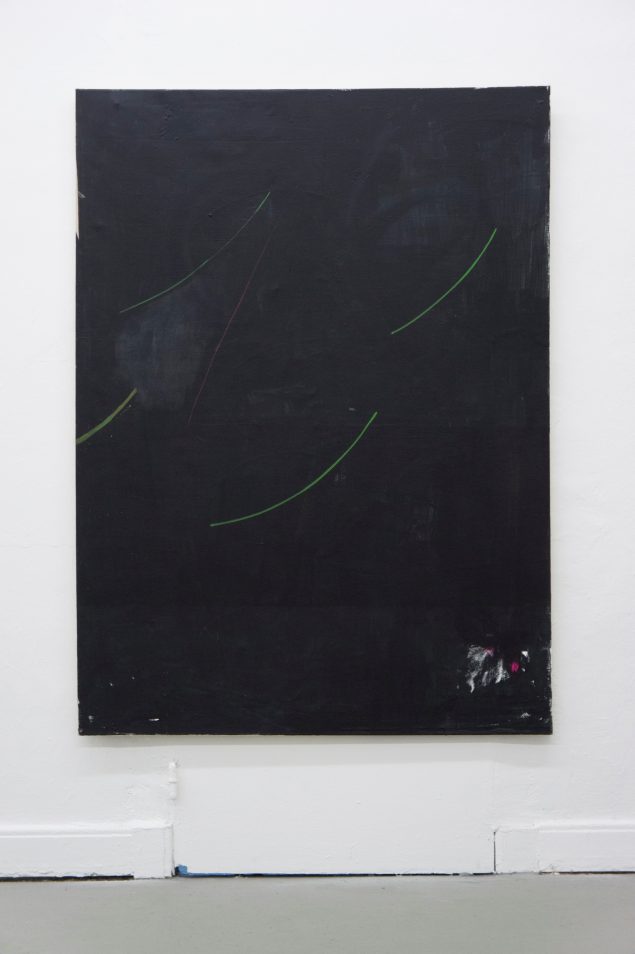Four blades of grass are falling, against night black. Nearby, a sculpture is thinking of its past.
The blades of grass are made of oblique green crescents, quickly but precisely inscribed into a canvas. Called Pyramide, this painting was made by Judith Kisner, whose pictures are like frame captures from the margins of seeing, where vision has a vibrant opacity. The daydreaming sculpture is a recent work by Eun Kyung Kim, called Mercury. In it, a photograph has been sandwiched between a large pane of glass, and wood. Both of these things connect to long, bent lengths of steel, one of which arches to the ground, weighted by a little sphere. The sandwiched photograph shows a small model sculpture. In so doing, it indicates a provenance – not a chain link of transactions and trades leading to the present, but a corporeal transformation, beginning with inspiration, in the electric fluid of thought, then moving through a paper study, and finally arriving in a work made from wood, glass and steel.
As much as describing things in the world, the words “painting” and “sculpture” demarcate a theatrical space, where objects have qualities and abilities. This isn’t such a strange situation, for anyone familiar with the transportive power of theatre. Kisner and Kim have accessed this force, by naming their exhibition The Ghost of the Rose, after Michele Fokin’s 1911 ballet, Le spectre de la Rose (following Theophile Gautier’s poem of the same name). To name is to cast a spell – to imbue a person or an object with a sense of their position in the world, and based on that position, certain aptitudes.
In Fokine’s ballet, an iconic image of love is killed, in order to unfold a truer scene of love, as a bizarre melting of fantasy, memory, and physical thrill. Online, you can find a video of the ballet, produced 1990. In the opening scene, a woman sits in a chair, holding a rose. As she dozes, her fingers loosen, and the flower falls. Shortly, the rose’s ghost enters a window, in the form of a male ballerina, clad in a leotard and petals. In this moment, we are moved from waking life, into a dream, just as Kisner’s and Kim’s works move us from a normative vision of painting and sculpture, into a conflicted recollection of those mediums and their imbrication in human cognition. Shortly, the male dancer whisks the dozing woman into dance, before departing through the opposite window. Colour is atmosphere, in this scene, as it is in Kisner’s paintings. The air is blue, shaded here and there by pink.
It strikes me that Kisner’s paintings, and Kim’s sculptures, live in the afterglow of grand artistic authority, as Fokine’s one scene ballet lived in the afterglow of epic, theatrical production. This may be why Kim’s sculptures carry memories of themselves, like implanted chips, and why they hover between spatial composition, and a realm where the identity of materials – which have moved from production line, to hardware store, to gallery – is candidly recalled. In Kisner’s Dots, red dots and triangles flood over a white rectangle, leaving an open territory of white. It is as if a code has been suspended at the verge of coherence. Meaning has been deferred, not out of laziness, but as a strategy for entering the murky space between the collective force of language, and the intimate space of subjectivity. In an email, Kisner has suggested to me that she paints self-referential “chiffren.” This is the Luxembourgish variant on the word cipher, and it gives Kisner’s paintings, with their cryptic visual lexicon, the quality of vapour.
I think this is why her paintings produce murmurs of anxiety, as I look at them. Our hostility to incompletion is similar to, and as strange as, our fear of ghosts. We shiver at the thought of spectres. Sometimes, when we wake up and scream at them, we even hate them. Why? Maybe our fear of the undead, and our fear of incompleteness, derive from a single neurosis.
Completion and forward movement are revered, in our daily lives. To shirk these expectations is to buy a ticket into social limbo. Set a task. Finish it. Convert it into profit. Repeat. These are the rules of a religion of productivity, which exorcises incompletion, in the same way that Christendom exorcises ghosts. Within this ideology, gestures of deferral and recollection have a political capacity. In Kisner’s and Kim’s work, these gestures articulate a right to slip between dimensions; to see in fragments and to move recursively through memories of oneself; to behave like ghosts, in manner of speaking.
(Text by Mitch Speed)

Eun Kyung Kim (b. 1986, Seoul) studied at Kunstakademie Düsseldorf with Tal R, Rebecca Warren, and studies now with Gregor Schneider. She received her BFA from Emily Carr University in 2012.
She exhibited in group shows at Contemporary Fine Art in Berlin curated by Tal R and Juergen Teller, Western Front in Vancouver. Eun Kyung Kim is based in Vancouver and Düsseldorf.
Judith Marrigje Kisner (b. 1986, Hulst) is a German/Dutch artist. She studied at Kunstakademie Düsseldorf with Tal R and is now doing her Master in the class of Jutta Koether in Hamburg.
J. M. Kisner has had several gallery, museum and group exhibitions, including the Museum of Modern art in Arnhem and the Contemporary Fine Art in Berlin curated by Tal R and Juergen Teller.
Kilde: TONENTON artspace

